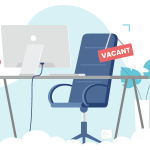Engineering Talent Shortage: What This Means for Your Firm’s Future
December 10, 2024

Canada’s engineering industry is at the forefront of shaping the future, from cutting-edge infrastructure to sustainable energy solutions and beyond. Engineers drive innovation, solve critical challenges, and lay the groundwork for progress. But amidst this promising landscape lies a significant challenge: a talent shortage that threatens to slow everything down. Projections indicate that by 2028, Canada could face a shortfall of over 100,000 skilled technical workers, particularly in engineering.

So, what does this talent shortage mean for your firm? This challenge goes well beyond a simple hiring issue. From delayed project timelines and rising operational costs to potential impacts on quality and safety, the consequences can ripple through your business in ways you might not realize just yet. By understanding these challenges, you’ll be ready to navigate this changing landscape, helping your firm stay resilient and well-equipped to thrive despite the pressures of a tight labour market.
Let’s take a closer look at what’s driving this talent shortage, how it impacts your business, and how you can stay ahead of the risks.
Understanding the Gap: What’s Fueling the Engineering Talent Shortage?
1. The Gray Wave: An Aging Workforce
If you’ve noticed that your most experienced engineers are nearing retirement, you’re not alone. Right now, over 30% of engineers in Canada are over the age of 50, and with every retirement, we’re losing decades of technical know-how. As younger professionals join the field, many still lack the hands-on expertise that comes with years of experience. This creates a knowledge gap that’s hard to fill, especially in an industry where even the smallest error can have big consequences.
Plus, engineering technology has advanced at lightning speed. While younger engineers are adept with new tools, they might lack the industry-specific experience held by seasoned veterans. This disconnect can slow down projects and even add pressure on senior staff.
2. A Missing Piece: Women and Diverse Talent in Engineering
While diversity efforts have gained momentum, there’s still a significant gap. Women represent only 20% of engineering roles in Canada. And diversity isn’t just a “nice-to-have”—it brings new perspectives and innovations, making teams stronger. The challenge here is finding ways to recruit and retain underrepresented talent, which ultimately helps your firm bridge the skills gap and attract a broader pool of qualified engineers.
3. A Dwindling Interest: Fewer Graduates Choosing STEM
It’s no secret that fewer students are choosing STEM fields like engineering, and this trend is shrinking our talent pipeline. A 2023 CIBC report highlighted that Canada is facing approximately 80,000 job vacancies nationwide, with half of these positions requiring skilled tradespeople. And with fewer graduates entering the field, your competition for top talent only intensifies. Canada needs more initiatives to promote engineering careers early on, and in the meantime, firms like yours are feeling the pinch.
4. A Talent Drain: Turnover from Mergers and Acquisitions
If your firm has experienced a merger or acquisition, you’ve likely seen the impact on employee retention firsthand. Shifts in culture, structure, and management styles can lead to turnover, which disrupts workflows and can cause significant setbacks. It’s a reminder of how fragile talent retention can be and why it’s critical to address these concerns proactively.
5. Geographic Imbalance: Talent Gaps Beyond the Cities
Engineering talent tends to cluster in urban hubs, leaving rural and less-populated regions struggling to attract skilled professionals. For firms outside major cities, recruiting becomes an uphill battle, as fewer engineers are willing or able to relocate. This concentration in urban areas not only widens the talent gap but can delay critical infrastructure projects in under-served areas, which in turn impacts both local economies and the overall reach of your business.
Why This Matters: The Risks and Impacts on Your Business
The engineering talent shortage is like a domino effect, where one nudge in staffing can set off a chain reaction with widespread consequences. When your firm can’t fill critical roles, projects start to slip, deadlines shift, and clients grow impatient. To compensate, your team is stretched thin, which can increase the risk of costly mistakes—one error leading to another, like dominos falling one after the next. Even a small misstep in a design or compliance oversight can ripple out, triggering rework, potential lawsuits, or jeopardizing safety standards on-site. Let’s take a closer look at some of the risks this shortage can pose for your firm.
RELATED: Why are employers losing the talent war?
1. When Projects Stall, So Does Productivity
With fewer engineers, projects can quickly fall behind. As timelines stretch, resources become strained, clients become frustrated, and your firm’s productivity suffers. Consider this: nearly 40% of engineering firms in Canada have reported productivity challenges due to understaffing. This productivity gap can lead to an increased risk of errors, which carries its own set of business liabilities such as professional liability claims.
2. The Real Cost of Error: Mistakes Aren’t Just Expensive; They’re Risky
When engineers are stretched thin, the quality of work can dip, increasing the likelihood of mistakes. In the high-stakes world of engineering, even minor errors can have big repercussions. Errors can lead to costly rework, client disputes, or worse, compromise safety. A talent shortage can make quality control challenging, especially when new hires miss out on guidance from seasoned engineers. Without this mentorship, newer professionals may lack the full training needed for complex projects, potentially compounding errors. And when firms hire quickly to fill roles without a good fit for skills or culture, it can create even greater risks that ripple across the organization.
RELATED: 3 Common Engineering Mistakes—and How You Can Avoid Them
3. Turnover and Business Liability: What’s the Connection?
High rates of staff departures can lead to critical business liabilities, particularly in industries like engineering where precision and expertise are essential. When an engineering firm loses an experienced employee and doesn’t have adequate support, the likelihood of oversight or negligence rises. For instance, a young graduate might inadvertently miss key checks without proper oversight, potentially leading to client disputes or even lawsuits.
RELATED: What does turnover have to do with business liability?
4. Health Issues for Employees: Burnout and Beyond
The talent shortage not only impacts project timelines but also puts immense pressure on your existing team. With fewer hands on deck, engineers often take on heavier workloads, leading to stress, burnout, and reduced sleep. When employees are stretched to their limits, their well-being suffers, and so does their productivity. This strain can make skilled engineers more likely to consider career changes or shift industries entirely, leaving firms like yours facing even greater staffing gaps and challenges to retain talent.
RELATED: Work, Sleep, Eat, Repeat: Managing the Burnout Crisis
5. Canada’s Economy Needs Engineers, and So Does Your Firm
The engineering talent shortage is more than a staffing issue—it’s a chain reaction impacting the entire economy and your firm directly. When critical projects stall or slow down, the effects reverberate across industries, inflating costs, tightening competition, and stretching resources thin. The urban concentration of engineering talent only adds to the challenge, as rural areas struggle to attract skilled professionals. This uneven distribution of talent can slow critical infrastructure projects in underserved areas, affecting local economies and increasing the strain on firms to adapt quickly and stay competitive in a challenging market.
What Can You Do? Steps for Risk Management
As competition for talent intensifies, firms without strong retention and recruitment strategies face a double impact: while struggling to fill open positions, they risk losing current employees to larger firms offering more perks. This talent drain disrupts team stability, knowledge transfer, and overall morale, setting off yet another line of dominos. And when you’re constantly replacing team members, burnout looms large. Overworked employees may become disengaged, which can lead to further turnover and even health issues, compounding the cycle.
In this setup, it’s clear that without a deliberate plan to address these gaps, engineering firms risk watching their structure—and resilience—collapse under the weight of cascading pressures. To keep these dominos standing, it’s essential to address the shortage head-on, your firm needs to adopt strategies that attract talent, strengthen retention, and protect against the unexpected.
1. Automate Wisely: Leveraging AI and Peer Reviews
AI tools can greatly benefit your business by handling repetitive or time-consuming tasks, such as data entry and initial design assessments. This allows your team to focus on more complex and creative projects that require human insight and innovative thinking.
But it’s essential not to let automation replace human expertise entirely. AI can miss critical details or context, which is why peer reviews are vital. Establishing a system for peer reviews ensures that experienced engineers can catch errors that AI might overlook, helping to maintain your firm’s quality and safety standards. By combining the efficiency of AI with the insights of human reviewers, your firm can enhance productivity while upholding its commitment to excellence.
RELATED: The Impact of AI on Engineering: Best Practices for Risk Management
2. Meet Talent Where They Are: Offer Flexibility
Today’s top talent values flexibility. If your firm can offer a flexible or hybrid work model, you may find it easier to attract younger engineers. Many professionals today value work-life balance as much as career growth. By offering flexibility, you’re not just helping with recruitment; you’re building loyalty among current employees too.
RELATED: The Hidden Cost of Office Work
3. Craft Your Brand: Attracting Talent Through a Culture of Growth
In today’s competitive job market, your company’s reputation as an employer is crucial. Highlight your commitment to innovation, diversity, and employee well-being through social media, industry events, and partnerships with educational institutions. By showcasing a culture of growth and inclusion, you can draw in a broader pool of candidates who resonate with your firm’s values.
To further strengthen this approach, implement a robust onboarding program that emphasizes mentorship. Pairing new hires with experienced engineers not only accelerates their skill development but also fosters engagement and a sense of belonging. This combination of a strong employer brand and effective onboarding creates a more cohesive team, turning new talent into valuable assets for your firm.
RELATED: Talent Attraction Strategies in a Job Seeker’s Market
4. Care for the Whole Employee: Prioritize Wellness with Better Benefits
Tackling workload, stress, and burnout is key to addressing the talent shortage, especially in high-pressure fields like engineering. When companies focus on mental health support and wellness programs, they show their employees that their well-being really matters.
By rolling out wellness initiatives, you’re not just creating a healthier workplace; you’re also boosting employee loyalty and satisfaction. When team members feel supported in their mental and physical health, they tend to stay engaged, motivated, and productive. Plus, a focus on wellness can lead to fewer sick days and lower healthcare costs, which is a win-win for everyone.
In the end, prioritizing employee wellness isn’t just about keeping your talent; it’s about building a strong organization that can roll with the punches and thrive in a competitive landscape. By fostering a culture that emphasizes well-being, your firm can attract and keep top talent while ensuring everyone stays productive and innovative.
5. Shield Your Firm with Insurance: Why Coverage Matters
All these steps can help minimize risk, but no risk management plan is complete without the right insurance coverage tailored to your unique risks. Insurance acts as a safety net, providing your firm with the protection it needs in various scenarios. Here’s how insurance can bolster your resilience:
a) Errors & Omissions (E&O) Insurance
The fast-paced, high-stakes nature of engineering increases the likelihood of occasional oversights or miscalculations. When resources are stretched thin, E&O Insurance provides essential financial protection against claims from dissatisfied clients. Rather than seeing it as a simple add-on, think of E&O as an investment in your firm’s long-term resilience and reputation management. It ensures you’re protected when minor mistakes threaten to impact your business reputation and, ultimately, your bottom line.
b) Employment Practices Liability Insurance (EPLI)
High turnover, rapid hiring, or internal restructuring all increase the risk of employment-related claims like wrongful termination or discrimination. If an employee sues, the financial and reputational costs can be substantial. EPLI not only covers these claims but also offers peace of mind during times of transition, allowing you to focus on running and growing your business without constant worry of legal repercussions. Investing in this coverage gives your firm a safety net in periods of operational strain, helping you manage organizational stress effectively.
6. Partner with a Specialized Risk Advisor
Working with a broker that understands your field gives you access to customized insurance solutions designed to meet the unique challenges of your industry. At PROLINK, we specialize in supporting engineering firms with over 30 years of experience and a deep understanding of the sector’s specific risks. We’re here to do more than provide coverage—we’ll help you identify areas of potential exposure, recommend effective risk mitigation strategies, and find the best-fit policies to support your firm’s growth and resilience.
Our team knows that no two engineering firms are the same. That’s why we prioritize learning about your business’s unique goals and challenges, ensuring you have a comprehensive risk management plan that’s built around your needs, not a one-size-fits-all policy.
The Bottom Line: Investing in Your Team and Protecting Your Future
In today’s challenging economic landscape, you may be feeling the pressure as a business owner. The ripple effects from market fluctuations can feel overwhelming, but the Canadian government is actively making advancements to tackle these issues.
While the shortage of engineering talent may feel like a long-term challenge, you have the power to turn it into a competitive advantage. By investing in your team’s well-being, creating an appealing culture, and implementing proactive risk management strategies, you’re not just managing a problem — you’re building a future-proof firm. And while you focus on these internal strategies, having a dedicated broker on your side, you can stop those dominos from falling—ensuring your business remains resilient amidst uncertainty. After all, with the right support, you can navigate the complexities of risk management and keep your business standing strong!
PROLINK’s blog posts are general in nature. They do not take into account your personal objectives or financial situation and are not a substitute for professional advice. The specific terms of your policy will always apply. We bear no responsibility for the accuracy, legality, or timeliness of any external content.




